
Statue Project
- Sponsors and Friends, Thank You!
- Dedication Ceremony, Stanton, KY
- More pictures from the dedication
- Letter from President Jimmy Carter
- Dedication Speech by Fontaine Banks
- Preparing the Statue Site
- The Artwork by Raymond Graf
- Clay City Times Article April 20, 2007
- House-Senate Joint Resolution 84
- Prestonsburg Statue Dedication
- First Annual Bert T. Combs Symposium
- Clay City Times Symposium Article
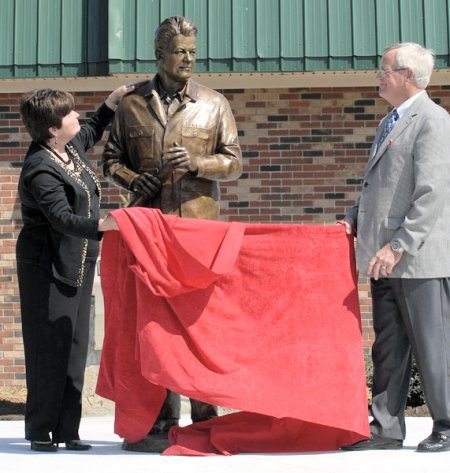
Sara Walter Combs, Chief Judge of KY Court of Appeals, and Project Director Joe Bowen unveil Governor Bert T. Combs Statue in Stanton, KY Photo: Tim Webb- www.timwebbphotography.com
Dedication and unveiling of the statues honoring Governor Bert T. Combs
April 20, 2007
in Stanton and Prestonsburg, KY.
Both Statues are now available for viewing. Please come by and enjoy a wonderful tribute to a truly great Kentucky Statesman.
Out of sincere respect and admiration for former Governor Bert T. Combs, the people of Kentucky have commissioned two life-sized bronze statues to honor his memory and legacy. The first statue is located in Stanton, KY, just a few hundred yards from the Bert T. Combs Mountain Parkway. The second is located at the Courthouse in Prestonsburg, KY.
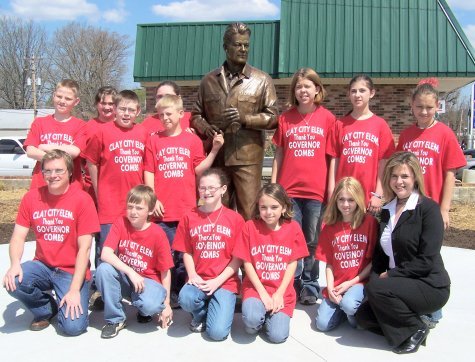
Following are two articles by Joe Bowen that appeared in "The Kentucky Explorer Magazine." These articles are published by permission.
Part I Of Two Parts:
Bert T. Combs Had Progressive Administration As Governor
Education And Highways Were His Top Priorities For Kentucky
By Joe Bowen - 2004
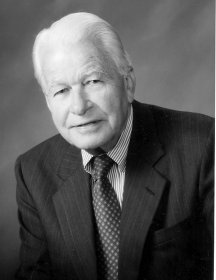
Bert T. Combs, 1911-1991
Governor of Kentucky 1959 - 1963
When Bert T. Combs ran for governor in 1955 my father, Bill Bowen,
was a staunch supporter, along with most of our friends and relatives.
Combs lost. Then in 1959 he ran again and became the governor that
brought Kentucky, kicking and screaming, into the modern age. For most
of us in Eastern Kentucky, Combs became an icon, a governor of the
working class people.
It was back then that I became interested in Bert T. Combs. Now as a
61-year-old man I have read hundreds of news clippings, official papers,
and two books about Combs' life. He lived on his farm, Fern Hill, only a
few miles from my home in Powell County, and I regret that I did not get
to know him personally.
Bert T. Combs was born on August 13, 1911, on Beech Creek in Clay
County, in the heart of the Eastern Kentucky mountains. Combs was reared
in a poor family of seven children. His dad, Stephen Combs, ran a
sawmill and farmed to make ends meet. His mom, Martha Jones Combs, was a
schoolteacher. She was young Bert’s inspiration to get a good education.
Bert attended Oneida Baptist Institute, and at age 15 was
valedictorian at Clay County High School. He later graduated first in
his class at Cumberland College. He saved his money from a job with the
Kentucky Highway Department so he could attend the University of
Kentucky Law School. There he graduated second in his class in 1937.
Bert first practiced law in Manchester. After realizing that family
and friends expected him to work for free he moved to Prestonsburg.
While living in Prestonsburg, in September 1942, he enlisted in the U.
S. Army as a private. In early 1945, as a lieutenant, he went overseas
to serve on General Douglas McArthur’s staff. He later became chief of
the War Crimes Department Investigating Section in the Philippine
Islands. For his work in apprehending and prosecuting Japanese war
criminals, Captain Combs received the Bronze Star and was decorated by
the Philippine government.
After the war Combs came back to
practice law in Prestonsburg. In
1951 Governor Weatherby appointed Combs to the Kentucky Court of
Appeals, the highest court in the state at the time. When the office
came up for election Combs beat the former and popular governor, Simeon
Willis, for the office.
In 1954 Governor Wetherby and Governor
Clements handpicked Combs to
run against A. B. Happy Chandler for governor. Combs, with his “mountain
twang” and sincere and sometimes shy demeanor was no match to the
backslapping, baby kissing, natural campaigner, “Happy.” So he lost.
Not much was seen of Combs for the next four years. But Combs was not
idle. When election time for the governor’s office rolled around in
1959, Combs was ready. He knew what he wanted to do for Kentucky. Wilson
Wyatt, a highly-respected attorney from Louisville, planned to run for
governor on the Democrat ticket, also. It was suggested that Combs run
as Wyatt’s running mate, and together they could beat “Happy” Chandler’s
man, Harry Lee Waterfield. After a poll showed that Wyatt couldn’t beat
“Happy’s” man, but Combs could, the two men agreed that Combs would run
for governor and Wyatt would run for lieutenant governor. They won the
primary and beat their Republican opponent in the fall election by the
largest margin ever, 280,000 votes. Combs became the first governor from
Eastern Kentucky since 1927.
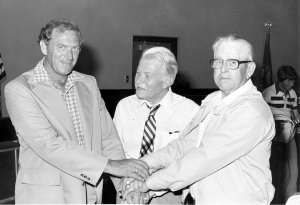
Bert T. Combs, governor of Kentucky during 1959-63, greeted political figures of Powell County. Edwin Rose, left, former county judge of Powell County; and Billy Joe Martin, county judge of Powell County at the time of this photograph, united with Governor Combs with a joint handshake. Barely visible in the background is Forest Meadows, future county judge of Powell County. (Photo courtesy of Floyd Anderson, 70 Allen Drive, Stanton, KY 40380.)
Combs, as the cliché goes, “hit the ground running.” His number one
priority was to advance Kentucky’s educational system. Speaking to the
Frankfort Rotary Club, September 11, 1963, Combs said, “When we entered
the 1960s our nation was at the summit of world leadership. It was
obvious that if Kentuckians were to play a significant role in that
leadership, we must be awakened to our responsibilities and
opportunities.
“We gave our attention first to education,
because every survey of
public opinion indicated that education of children held first place in
the hearts of Kentuckians. I think most Kentuckians feel that if there
is a single key which can unlock the door to a brighter future that key
is education.”
To advance education and accomplish other visions
that Combs had for
Kentucky would take money. He recommended a three percent sales tax,
which a small portion would go to pay a veterans’ bonus. With the sales
tax he gave all Kentucky veterans a bonus and pumped an additional
$267,870,792 into public education from 1960 to 1964. This was the key
Governor Combs applied to the lock.
During Combs’ four years
teachers’ salaries nearly doubled, helping
to keep good teachers in Kentucky. Five hundred one-room schools were
eliminated. Thirty new high schools and 102 new elementary schools were
built, and additions were made to 87 high schools and 181 elementary
schools. This created 4,653 new classrooms in Kentucky.
During Combs’
years as governor Kentucky’s support for higher
education increased by 115%. He started the Community College System and
Kentucky Educational Television (KET) that both serve our citizens so
well today.
Combs’ second priority was highways. The Federal
Highway Program, the
interstate system, was well-under way when Combs became governor. So he
“hit the ground running,’ again. As the interstates’ construction was
moving north and south through Kentucky, Combs was determined that
Kentucky would not embarrass itself because of traffic bottlenecks due
to unfinished four lanes. Kentucky was actually ahead of other states in
building these highways. Combs felt that we also needed four lanes
traveling the state east and west. So during his term he finished the
Western Kentucky Turnpike and the Mountain Parkway in the east. Before
he left office the Bluegrass Parkway was well on its way into central
Kentucky.
The Mountain Parkway was most dear to his heart though.
Eight years
after Combs left office Governor Louie Nunn honored Combs by officially
naming the two ribbons of concrete the Bert T. Combs Mountain Parkway.
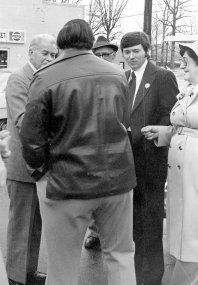
During Bert T. Combs’ term as governor of Kentucky (1959-63) his top priorities were education and roads. He started the Community College System and Kentucky Educational Television (KET) that both serve our citizens so well today. The Mountain Parkway, which runs through Clark, Powell, Wolfe, and Magoffin counties, was most dear to Governor Combs. Eight years after he left office the Bert T. Combs Mountain Parkway was named in his honor. In the photo above the Governor, left, visits with citizens of Powell County in Stanton, Kentucky, in 1979. Pictured are: John Brewer, with back to camera; Shelby Martin, wearing hat; Floyd Anderson; and Reba McQueen. (Photo courtesy of Floyd Anderson, 70 Allen Drive, Stanton, KY 40380.)
Before he was elected governor Combs met many times with Bill May, a
highway engineer from Pikeville, and discussed both their dream of
building a highway for the Eastern Kentucky mountain people. The highway
was being designed before the election. There was a rumor that May asked
Combs how they would get paid? Supposedly Combs told him, ‘You won’t if
I don’t get elected governor.’
The Mountain Parkway was known
as a developmental highway: One of the
first in the country. Generally, existing traffic flow has to be great
enough to justify the financing of a new highway. That kind of traffic
flow between the mountains and the Bluegrass didn’t exist. Combs,
undaunted, convinced the powers that if Kentucky would build the
Mountain Parkway the mountain people would drive to the Bluegrass to
shop and do business, and the central Kentucky people will visit the
mountains. Combs and his financial staff had to meet with six different
financial institutions in New York before they found one that would help
Kentucky build the Mountain Parkway. The tolls paid for the highway
ahead of schedule, and the toll plazas were removed in 1985.
During the Mountain Parkway dedication at the Campton interchange on
May 8, 1963, Combs said, “This highway, with its extensions, will reveal
to our visitors some of the most beautiful scenery in America, the
southern Appalachian Mountains. And the visitors will come, legions of
them, now that the barriers of isolation have been pierced by these
rapiers of concrete. They will come to behold the grandeur of the hills
and to enjoy the hospitality of the mountain people.
“We hereby dedicate the Mountain Parkway as a lasting symbol of the
perseverance and hopes of the mountain people and to the continued
progress and well-being of all the people of our Commonwealth.”
In reading through the Bert T. Combs papers I have found several
places where he had told someone, “I would like to leave some sort of
track, showing that I’ve been here.” And tracks did he leave for all
Kentuckians, but especially for his mountain people.
Another one of his projects of the heart was the Kentucky State Parks
system. Bert believed that with the natural beauty so prevalent in
Kentucky, the rich history, and the hospitality of the state’s people,
we could become a destination for millions more tourists each year. He
believed that the parks could build resort hotel accommodations that
were comfortable and hospitable, yet affordable to the American family.
So with monies appropriated he changed a park system that was mostly
campgrounds into resorts. He enjoyed visiting the parks after some of
the hotels were built. He took great pride in what they would do for the
economies of each community where they were located. His visits were
somewhat like an inspection.
He visited one particular park.
The trees were awesome driving into
the entrance. The creek was clean. The hotel was just what he expected.
Inside the lobby was beautiful with the wooden floors and the massive
stone fireplace. He sat down in the dining room, admiring the furniture,
the rustic chandeliers, the table linens, and the view outside
overlooking a mountain valley. Then the waitress walked over to his
table. She had a toothpick sticking out the side of her mouth and asked,
“Whatcha ont?’
I guess he figured he couldn’t get everything perfect.
Combs felt that if he was with his people he could better listen and
learn what the people expected out of their government. He took the
office of the governor to the people 41 times, the only political
project of its kind in the United States. Combs and his staff actually
set up shop in 41 different locations and invited the people to come in
and tell them what was on their minds and suggest possible solutions.
The staff didn’t completely enjoy the experience but Combs knew it was
important. He was at his best with the people.
Out of these
meetings came the idea of over 1,000 litter barrels
marked and placed along Kentucky highways. Ponies and saddles were
bought for orphans, rowboats for the boys’ camp near Kentucky Dam, and
coloring books for the mentally impaired. He moved the Derby breakfast,
which had been for the governor’s cronies in the mansion, to tents on
the lawn, and everyone was invited. The Derby breakfast is still done
the Combs way.
He built amphitheatres in some of the parks and
encouraged live dramas. He even encouraged his pretty teenage daughter, Lois, to work as
a waitress at Cumberland Falls State Park and Kentucky Dam.
Once a year he invited journalists from all over the state to meet
with him and his staff in Frankfort. They were to ask any questions they
wanted, and they would be answered objectively.
Combs was
ridiculed harshly for building the floral clock between the
Capitol and the Annex. Even some of his own people advised him not to
build it. They said it would be a political nightmare. The clock turned
out to be one of the most popular tourist attractions in Frankfort and
still is after 43 years.
Combs’ executive order banning
discrimination may have come out of
one of the 41 meetings. It also may have come from the idea that Combs,
being a mountain man, knew what it meant to be a member of a minority
group. He polled the House and Senate to see if a law could be passed to
end discrimination. When he knew that was not possible he signed an
executive order to end discrimination. He had often said that, “An end
to segregation is coming and that those who fight it are only spreading
bitterness.”
President Kennedy wrote Combs a personal letter thanking him for
stepping forward and doing what was right. The subject weighed heavily
on Combs’ thinking. In March 1963 Combs addressed the Conference for
Brotherhood in Chicago.
He spoke, “Equality and cooperation
are the lamps of civilization. As
civilized people, then, we Americans must accept the challenge and lead
the way by lighting the torch of freedom for oppressed people, both at
home and all over the world.
“The whole universe knows
first-handed that while America attempts to
provide food, comforts, and protection for most of the distant people of
the world, it still refuses to provide here at home the most vital of
all constitutional rights, first class citizenship for everyone. But the
time has come when the opponents of decency and right must recognize the
inevitability of change.
“At the beginning of our great
nation Americans assumed a mortgage on
their freedom, but after almost two centuries we are in the throes of
bankruptcy, because we are behind on our payments to the United State
Constitution.
“In this day and time, freedom has become more
than an academic word.
It is no longer sufficient merely to talk and write of the ingredients
of the good life and the dignity of man. In this grave hour in which you
and I are privileged to live, fraught periodically with great pride and
great promise, the value and durability of full citizenship rights are
to be found more in our actions than our words, in our collective
efforts and individuals beliefs.”
Writer’s Note:
Bert T. Combs’ last chapter and shining hour was yet
to come. Check out the September issue of The Kentucky Explorer to find
out more about Bert Combs’ contribution to our society. Also, watch for
some exciting news regarding an event concerning Bert Combs that will be
happening this year.
Editor’s Note: In the July-August 2004 issue of The Kentucky Explorer Joe Bowen shared the first part of a two-part series of Bert T. Combs’ progressive administration as governor of Kentucky. Combs’ top priorities for the state were education and highways. For most of the residents in Eastern Kentucky, Combs became an icon, and was considered a governor of the working class people.
Now, Joe Bowen of Taylorsville, Kentucky, continues with part two of his story with exciting news.
Part II
Governor Combs To Be Honored With Memorial In Powell County
Fern Hill On Cane Creek Was The Beginning Of A More Relaxing Time For The Governor
By Joe Bowen - 2004
In the first article about Bert T. Combs I ended with, “Combs’
shining hour was yet to come.” But before that shining hour Combs had
heartaches like most of us.
In 1954 U. S. Senator Earl
Clements and Governor Lawrence Wetherby
decided that Combs could be the man to become Governor of Kentucky and
unite the Democrat party that Happy Chandler was splitting into
factions. One night they called Combs to the Governor’s Mansion to
discuss the possibility. Combs told them that he couldn’t see himself as
governor. He also told them that he had a little boy who was handicapped
and didn’t want anything to interfere with his son’s happiness.
In an interview with George W. Robinson (Bert T. Combs, An Oral
History), Governor Lawrence Wetherby said that Combs had problems over
the boy. Wetherby said they continued to talk about Combs running for
governor and he would come back to the boy. “Well,” Combs said, “I’m
just a little reluctant because of the fact you get into a campaign and
people will talk about it.” Combs was also worried about how Tommy would
be cared for. Maybe a little aggravated, Wetherby finally told Combs,
“You can do a lot more for him as governor than you can by not being
governor.”
Combs was finally convinced and agreed to run.
(He lost in 1955 to A.
B. “Happy” Chandler, but ran again in 1959 and won.) Tommy stayed a
major part of Combs’ life to the end. Combs had birthday gatherings in
honor of Tommy late in life, while living at his farm, Fern Hill, in
Powell County.
Combs worked hard as governor, introducing
184 new and worthwhile
programs in Kentucky. It was extremely important to Combs that the
person who followed him into the governor’s office would continue those
programs. So he backed Ned Breathitt for governor. Breathitt had helped
Combs during his governorship. Breathitt won and the election cycle for
the 1967 governor’s race was coming up and a lot of people wanted Combs
to run again. They were sure he would win because he and Breathitt had
grown so popular. Combs followers knew that the successes of the state
government of the past eight years could go on for at least four more.
Combs agreed at first to run, but at the last minute changed his mind.
When asked why he didn’t run, Combs replied, “By reason of my family
situation, personal problems, and my age. I decided I wanted to go with
the court.”
Governor Combs’ wife, the former Mable Hall, a mountain woman
herself, didn’t want Combs to run again. So he didn’t. A short time
after that, in 1969, Bert and Mrs. Combs divorced.
In January 1967 Combs was nominated to serve on the Federal Court of
Appeals. In April, Combs was endorsed by the United States Senate
Judiciary Committee and confirmed by the United States Senate as Federal
Appeals Judge of the Sixth Circuit. The Courier-Journal reported that
this judgeship removed Combs from Kentucky politics and that he was one
of the “most colorful, popular, and respected figures in Kentucky.” He
would serve in Cincinnati, removing him from the political action of
Kentucky that he so enjoyed.
Later Combs said the
“Federal Appeals Court is somewhat isolated.” In
Robinson’s oral history, Tommy Carroll said, “Combs quickly became a
very lonely man in Cincinnati. He was miserable in that position.”
Many people thought that Combs resigned the court to run for governor
in 1971. Combs later said that a long-time friend, John Tarrant, had
encouraged him on several occasions to come into his law firm as a
partner, which he did.
Friends across the state had encouraged
him to run for governor in
1967 and 1971. His second wife, Helen Rechtin, from Louisville, was also
encouraging him in 1971. He ran for governor in 1971, and to the dismay
of thousands lost to Wendell Ford.
That series of events,
not running for governor in 1967, the divorce
from Mable Hall, always worrying about his son’s (Tommy) well being,
sitting in a lonely seat of the U. S. Court of Appeals, losing the 1971
election, and then a second divorce, were major bumps in the road to a
great Kentuckian. But things would get better.
He settled in as senior partner of Wyatt, Tarrant, and Combs Law
Firm; the largest in Kentucky.
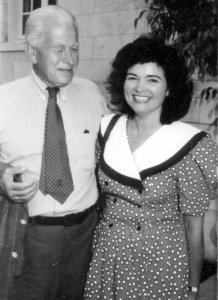
Bert T. Combs hired Sara Walter as an assistant in his law firm in 1979.The couple was married December 30, 1988. The ceremony was held at Fern Hill, the beautiful farm and log home where the couple resided, in Powell County. (Photo courtesy of Sara Walter Combs.)
In 1979 Combs hired an assistant lawyer, Sara Walter, to help with
his workload in the law firm. Their mutual admiration developed into a
deep and abiding love. Combs had bought a farm in Powell County on Cane
Creek. He wanted to live in the mountains close to his grandchildren in
Knott County yet have a comfortable drive to his Lexington law office.
Combs assigned Sara the job of building him a home on Cane Creek. She
immersed herself in the project and became the construction manager and
assistant to the architect. After a year the result was an elegant, log
home nestled at the foot of a mountain overlooking Cane Creek and its
lush, green valley.
Sara named the farm and home Fern Hill after a poem written by Dylan
Thomas. To Combs the poem described Fern Hill and what it was and what
it would become. Sara Walter Combs told The Clay City Times in 1992 that
Fern Hill was “time-out from time itself for the judge.”
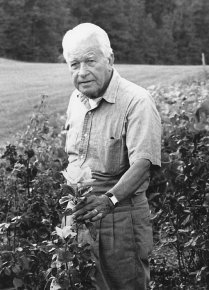
Governor Bert T. Combs stands in his beautiful rose garden, about 1989, at Fern Hill in Powell County. Combs worked hard as Kentucky’s governor. He introduced 184 new and worthwhile programs during his administration. (Photo by Tim Webb, Richmond, KY)
There, with Fern Hill, the Lexington office, and Sara Walter at his
side, Combs was the legal council for 66 of Kentucky’s poorest school
districts, without financial compensation. They sued the governor of
Kentucky and the General Assembly claiming the Kentucky educational
system was unconstitutional.
The representatives of these
66 school districts convinced Combs,
according to Combs’ article in the Harvard Journal on legislation, that
Combs, “at one time claimed to be Kentucky’s education governor.” They
also reminded Combs that he “was now holding himself out as a top-notch
lawyer.” Combs agreed on both accounts.
In the Harvard
article Combs said, “they also reminded me that
Kentucky’s General Assembly had never (at least within the memory of any
living person) adequately financed the state’s public schools. The
results, according to them, was that the children of Kentucky were being
deprived of their constitutional right to a decent and equal education,
and that we as onlookers were wasting our “seed corn” for the future.”
Sara Walter, Combs’ closest confidant and legal assistant, worked on
the lawsuit with Combs for months and months, preparing it to be
presented to the court. She also helped Combs write the very
enlightening and, at the end, humorous article for the Harvard Journal.
The suit was filed in 1985. According to the Harvard account the
courts determined Kentucky’s elementary and secondary system was
inadequate and inefficient, the opportunity to obtain an adequate
education is a fundamental right protected by the Kentucky Constitution,
and the wide disparity in funding between the affluent districts and the
poor districts was discriminating to the children in the poor districts;
violating the equal protection clause of the 14th Amendment to the
United States Constitution and Section 183 of the Kentucky Constitution.
The court’s decision was taken to the State Supreme Court, where the
lower court’s decision stood. Because of this suit and the court’s
decision, we have the Kentucky School Reform Law.
This law completely changed Kentucky’s educational system for the
better.
I would recommend that anyone interested in education in Kentucky
read Combs’ article in the Harvard Journal on Legislation, Vol. 28, No.
2, dated Summer 1991, and those interested in Combs should read
Robinson’s oral history mentioned above.
Shortly after the
oral argument in the Supreme Court, Bert and Sara
were married on December 30, 1988, at their log home, Fern Hill, in
Powell County.
In several articles the Courier-Journal
and the Lexington Herald
quoted Combs as saying that as a student, he attended schools “that had
no library, no laboratory, a very sketchy curriculum, poorly paid
teachers, inadequate buildings, all the rest; and I am very conscious of
the fact that it has been a handicap to me through my whole life.”
I couldn’t imagine Bert Combs, the great man that he was, feeling
inadequate. I asked Sara Combs, who is now Chief Judge of the Kentucky
Court of Appeals, if this Combs statement was accurate. She assured me
that he lived with the thought his entire life.
The move to
Fern Hill was the beginning of a more relaxing time for
Bert Combs. He was still practicing law in Lexington, enjoying Fern
Hill, and doing light farming.
Then tragedy struck.
It was December 3, 1991, cold and rainy. Combs
called his wife, Sara, from Lexington and told her he would be a little
late getting home. Darkness fell, the river was rising, and he had not
arrived home. A worried Sara began calling friends and neighbors. No one
had seen or heard from him since he left his office in Lexington. Those
in Lexington knew he was headed home. Soon hundreds of people were
hunting for Combs.
Bert Combs’ route home took him off
the Bert T. Combs Mountain
Parkway at Stanton; onto Highway 15, a drive of three miles; then a left
at Rosslyn, on his way to Cane Creek. At Rosslyn he would drive across
the lane which crossed Red River. On that dark night, due to heavy rain,
the Red River was flooding the road near the bridge.
Most of us in the valley, when we see the water rising over the road
at Rosslyn, we stop and decide, “Yes it’s safe to cross, or no it’s too
deep.” We all do it and several times each year someone has to be
rescued from their vehicle.
While everyone was looking
for Combs that night they wouldn’t utter
the possibility that most were thinking.
After daybreak
his car was spotted partially submerged, but Combs
wasn’t in the car. His body was found one-quarter-of-a-mile down the
river. Rob Matthews, Stanton Chief of Police was one of those who found
him. I asked Rob, “Did he drown?” He answered, “No, he had gotten out of
the car, got his coat and shoes off, and probably was swimming.” Rob
continued, “I found him out of the water, and that 80-year-old man was
still holding on to a two-inch tree.” Hypothermia had taken the life of
this tough mountain man.
After Bert Combs’ funeral the
Courier-Journal reported, “Bert Combs
was no saint.” John Ed Pearce, a long- time friend of the former
governor reminded the mourners with good humor, “He was a man in all
that word connotes. A man who loved good books, good talk, and good
stories. A man who loved deeply.”
After part one of this
article appeared in The Kentucky Explorer I
received a letter from David L. Jackson of Frankfort. Mr. Jackson, at one time, was president of Oneida Institute, and
his wife was a distant cousin of Governor Combs. One year Combs was
their commencement speaker. Mr. Jackson wrote Combs a thank you letter
and told him, “because I was married to a Combs, perhaps, I was
prejudiced, but, I thought you were the best governor that Kentucky ever
had.”
Jackson said he received a reply a few days later. It simply read,
“You should be prejudiced,” signed, Bert T. Combs.
In Robinson’s oral history, Wendell Butler, former state
superintendent, told the story on the campaign trail when Combs met a
man and asked for his vote. The man said, “Judge, I wouldn’t vote for
you if you were Saint Peter.” Combs shot back, “You couldn’t vote for
me. You wouldn’t be in my district.”
While Combs held
the office of governor he became a beekeeper. He
cared for five stands of bees on the mansion grounds. When he left
office and set up residence in Lexington he took the bees with him. The
bees began to fail in producing honey. To a friend he commented, “I
sorta expect that my queen bee has taken up with a horse fly.”
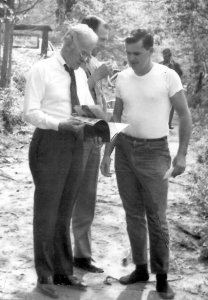
Joe Bowen, right, met Governor Bert T. Combs at the Red River Gorge in 1971. Governor Combs asked Bowen not to leave Powell County, for he was needed there, but he did leave for 31 years. Bowen is planning to move back to Powell County within the next year and plans to help the people however God sees fit. (Photo courtesy of Joe Bowen.)
Joe Bowen, P. O. Box 425, Stanton, KY, 40380, shares this article with our readers.
Powell County native, Joe Bowen, originated the idea for the Bert T. Combs statue and is the primary driving force behind the project. Joe was also instrumental in the Woody Stephens statue that now stands at the Powell County Courthouse.
